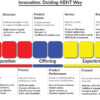
In a world obsessed with disruption and novelty, the idea of cloning success might seem uninspired, almost heretical. We’re conditioned to chase the next big thing, to forge our own unique paths, to be wary of the well-trodden. But what if the key to achieving your goals doesn’t lie in reinventing the wheel, but in learning from those who’ve already mastered the ride?
History is littered with examples of pioneers who paved the way for future generations. Isaac Newton famously declared, “If I have seen further than others, it is by standing upon the shoulders of giants.” From Steve Jobs drawing inspiration from Xerox PARC to Marie Curie building upon the discoveries of Henri Becquerel, some of the greatest breakthroughs have come not from radical innovation, but from building upon the foundations laid by those who came before.
Why Emulating Works:
- Efficiency: Trying to reinvent everything from scratch is a herculean task, one that wastes precious time and resources. Borrowing proven strategies and adapting them to your context allows you to jump-start your journey, avoiding costly detours and false starts.
- Validation: When you emulate someone who has already achieved success, you gain a level of validation for your own goals. Their journey serves as a proof of concept, demonstrating that what you’re aiming for is not only possible but attainable.
- Accelerated Learning: Studying the successes and failures of others acts as a crash course in navigating the terrain you’re about to embark on. You learn from their mistakes, avoid their pitfalls, and glean valuable insights that can expedite your own progress.
Emulating with Intention:
While simply copying someone else’s blueprint might lead to a dead end, emulating success requires active engagement and thoughtful adaptation. Here are some tips to make the most of it:
- Identify the right role models: Choose individuals whose values and goals align with yours, but who also possess strengths and experiences that complement your own unique skill set.
- Deconstruct their success: Don’t just copy the surface—dig deeper to understand the principles, habits, and strategies that underpin their achievements. What were their key decisions? How did they overcome challenges?
- Adapt and personalize: Don’t be a carbon copy. Analyse your own strengths and weaknesses, and tailor the borrowed strategies to your specific context and resources.

Inspiring Examples:
- Oprah Winfrey: Oprah built her media empire by studying talk show legends like Phil Donahue and Barbara Walters, adapting their formats, and adding her own personal touch.
- Walt Disney: Disney famously borrowed heavily from European fairy tales and theme park concepts, but infused them with his own unique blend of animation, storytelling, and imagination.
- Elon Musk: From Tesla’s inspiration in electric car startups to SpaceX’s focus on reusable rockets, Musk has consistently drawn upon and improved upon existing technologies to achieve revolutionary results.
- Kiran Bedi: From IPS Inspiration to Changemaker: Kiran Bedi, the first woman IPS officer in India, didn’t just follow in the footsteps of pioneers like Kamla Nimbkar. She took their commitment to public service and community transformation to a whole new level. Inspired by Verghese Kurien’s “Anand Milk Union” model, she revolutionized prison reforms in Tihar Jail, turning it into a model of rehabilitation and self-sufficiency.
- Infosys: Riding the Software Wave: N.R. Narayana Murthy and his colleagues didn’t invent software outsourcing. They saw the success of American pioneers like H. Ross Perot and adapted it to the Indian context. By capitalizing on India’s skilled workforce and cost advantage, Infosys became a global IT leader, paving the way for countless other Indian tech companies.
- Amul: From Local Butter to Global Dairy Giant: Verghese Kurien didn’t reinvent cheesemaking. He took inspiration from Swiss cooperatives and adapted them to empower Indian dairy farmers. Amul transformed India from a milk-deficient nation to the world’s largest milk producer, showcasing the power of emulating and scaling successful models.
- Dhirubhai Ambani: From Gas Station to Reliance Empire: Dhirubhai Ambani wasn’t the first Indian entrepreneur, but he learned from and surpassed some of the best. He studied Rockefeller’s vertical integration strategies and applied them to Reliance, diversifying from textiles into petrochemicals and telecommunications, creating a business behemoth.
- Mary Kom: Boxing Her Way to the Top: Mary Kom didn’t emerge from a vacuum of boxing success. She drew inspiration from legends like Dingko Singh and Mohammed Ali, adapting their techniques and training regimes to excel in a male-dominated sport. Her story stands as a testament to the power of emulating sporting heroes and carving your own path to glory.
Beyond Emulation: The Indian Twist
While emulating successful models can be a powerful tool, it’s crucial to add the unique Indian masala to the mix. Remember:
- Contextualize: Adapt borrowed strategies to the specific socio-economic realities of India, ensuring your approach is inclusive and impactful.
- Innovate: Don’t be afraid to add your own twist, injecting Indian ingenuity and resourcefulness to create something truly groundbreaking.
- Collaborate: Build upon the collective wisdom and support of the Indian community, leveraging networks and partnerships to amplify your success.
By standing on the shoulders of Indian giants and infusing their lessons with our own unique spirit, we can write our own chapters in the inspiring saga of Indian achievement. So, let’s draw inspiration from chaiwalas and champions, adapt, innovate, and collaborate to reach new heights of success!
Remember: Emulating success doesn’t equate to blind imitation. It’s about leveraging the wisdom and experience of those who have gone before, understanding the “why” behind their achievements, and then tailoring their approaches to your own unique path. By standing on the shoulders of giants, you gain a higher vantage point, allowing you to see further, reach greater heights, and ultimately achieve your own extraordinary success.
Prof. Dr. Prahlada N. B
31 December 2023
Doha, Qatar.
Additional Resources:
- “Think Like a Monk” by Jay Shetty: This book shares inspiring stories of Indian innovators and entrepreneurs, highlighting the importance of purpose and mindfulness in achieving success.
- “I Do What I Do” by Raghuram Rajan: This memoir by the former Governor of the Reserve Bank of India offers valuable insights into leadership, decision-making, and navigating complex challenges in the Indian context.
- “The Story of Indian Entrepreneurship” by Gita Piramal: This book chronicles the journeys of iconic Indian entrepreneurs, providing valuable lessons and inspiration for aspiring business leaders.
- “Zero to One” by Peter Thiel: This book explores the power of unique value creation and challenges the idea of blindly copying existing models.
- “Steal Like an Artist” by Austin Kleon: This handbook encourages creative inspiration through emulation and adaptation, emphasizing the importance of building upon the work of others.
- “Mindset: The New Psychology of Success” by Carol Dweck: This book reveals the power of a growth mindset, encouraging individuals to learn from others’ successes and view challenges as opportunities for improvement.

















Your blogs are a minefield of information and experience!
ReplyShows your deep knowledge and clear goals!
Keep up the good work sir…